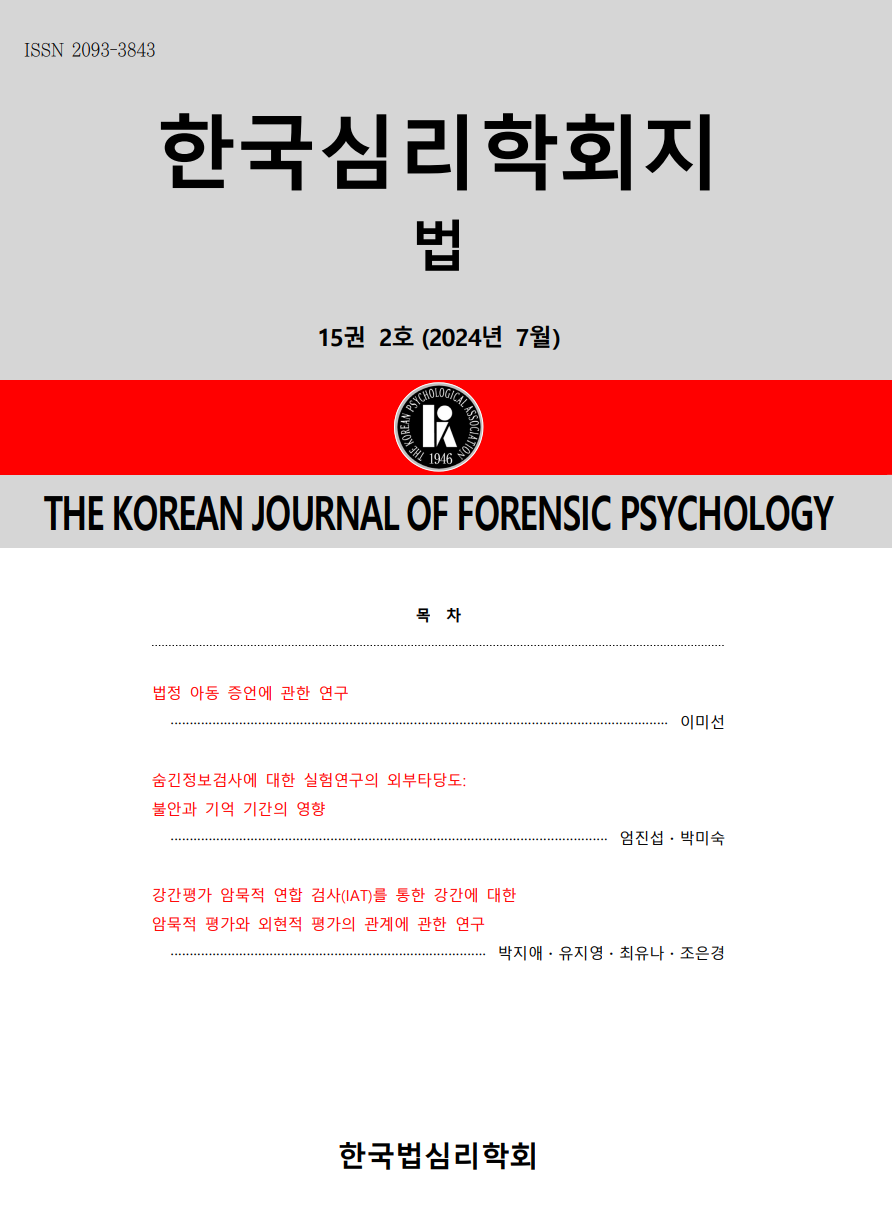open access
메뉴
open access
메뉴 ISSN : 2093-3843
ISSN : 2093-3843
The present study examined the accuracy with which police officers identified the types of questions asked during investigative interviews with alleged child abuse victims. Factors affecting their accuracy were also explored. One hundred and twenty Korean police officers were asked to classify 50 questions into one of five categories (invitations, facilitators, directives, option-posing and suggestive prompts). The overall accuracy rate was 65.6%; invitations were correctly classified most often (85.5%) whereas suggestive questions were least accurately identified (42.3%). Police officers tended to overestimate their use of invitations by incorrectly identifying directive questions as invitations. Suggestive questions were mistakenly identified as option-posing questions (22.2%), directive questions (15.1%), and even invitations (5.6%). Being trained to use the NICHD Protocol was the only factor significantly predicting higher accuracy.
The current study aimed to investigate the frequency differences in presentation of alibi and evidence by factors ̒day̓ and ̒time̓. We analyzed the frequencies of presenting alibis, physical evidence and witness evidence, and investigated the base rate by day (weekday / weekend) and time. A total of 282 respondents participated in this study through self-report online questionnaires. Participants were randomly assigned to one of 8 conditions that consisted of either the day (Tuesday / Saturday) and the time (3:00 / 9:00 / 15:00 / 21:00), and then they were asked to generate their alibis (location), physical evidence, and witness evidence to prove their innocence from mock robbery that they did not commit. Chi-square test was utilized to verify differences in the evidence reported by participants for certain day and time. In addition, binary logistic regression analysis was used in order to investigate the effect of day and time on the evidence. As a result, the day influenced whether family members witness evidence was reported and the time influenced all types of physical and witness evidence. In other words, people are most likely to report the witness evidence with the weakest reliability on weekend, and believable physical and witness evidence were least often reported at 3am in which crimes are most frequent. This study shows that a perfect alibi and evidence to prove innocence in the investigation process may not be possible. Finally, the limitations of the present study and suggestions of subsequent study were discussed.
본 연구는 Ruiz와 Edens(2008)의 연구결과를 통해 나타난 PAI의 내현화와 외현화 척도로 구성된 2요인 모형의 유용성을 살펴본 연구에서 시작되었다. Ruiz 등(2008)의 선행연구를 바탕으로 한국 청소년들을 대상으로 실시한 PAI-A 척도들의 내부 구조를 살펴보았고, 이를 11가지 임상 척도와 내현화와 외현화의 중요한 징후로 나타나는 자살관념(SUI) 척도와 공격성(AGG) 척도를 포함한 총 13가지 척도의 2요인 모형이 적합한지 알아보았다. 이를 위해 S시와 A시 소재의 소년원과 서울의 한 고등학교에서 14세부터 21세의 청소년들을 대상으로 PAI-A를 실시하였다. 그 결과 PAI-A 전체척도와 하위 척도의 cronbach’s α 값은 몇몇 척도를 제외하고 전반적으로 적절한 수준을 나타내었다. 13가지 척도의 상관분석을 실시한 결과 유사한 성격의 척도들은 높은 상관관계를 나타내었고, 관련성이 낮은 척도들은 낮은 상관관계를 보였다. 탐색적 요인분석에서는 한국 청소년들의 내현화와 외현화 요인 구분이 Ruiz 등(2008)의 PAI 2요인 모형의 내현화 와 외현화 척도와 다르게 나타났다. 큰 특징으로는 PAI에서 외현화 척도로 분류된 경계선적 특징(BOR) 척도와 망상(PAR) 척도가 PAI-A에서는 내현화 척도로 분류되었다. 또한 확인적 요인분석 결과 2요인 모형의 적합도가 높지는 않아 좋은 모형으로 볼 수는 없지만, 각 적합지수가 수용수준에 근접하여 있었다. 따라서 PAI 2 요인 모형이 한국 청소년을 대상으로 실시한 PAI-A 2요인에 만족할만한 적합도를 보이지는 않았지만 적합한 모형에 가깝다고 볼 수 있었다. 따라서 본 연구는 한국 청소년에게 적합한 2요인 모형을 찾으려고 시도하였다.
This study began with a study of the usefulness of a two-factor model consisting of the internalized and externalized measures of PAI, which were found through the study of Ruiz and Edens (2008). Based on the previous study of Ruiz et al. (2008), we examined the internal structure of the PAI-A scales for Korean adolescents and verified them with 11 clinical scales and two additional measures of SUI Scale and AGG scales. For this purpose, aged 14 to 21 adolescents conducted PAI-A at a reformatory and a high school in Seoul. As a result, the cronbach's α value of the PAI-A total scale and the subscale was found to be generally adequate except for some scales. Results of correlation analysis of 13 scales, the similar scales showed a high correlation and the low relevant scales showed a low correlation. In exploratory factor analysis, the distinction between internalizing and externalizing factors in Korean adolescents was different from the of the two factor model of Ruiz et al. (2008). Moreover, the BOR and PAR scales of PAI were classified as externalizing scale, but the BOR and PAR scales of were classified as internalizing scale in PAI-A. In addition, confirmatory factor analysis revealed that the two - factor model was not suitable. These results indicate that the PAI two-factor model is not suitable for PAI-A results in Korean adolescents, and this study attempted to find a two-factor model suitable for Korean adolescents.